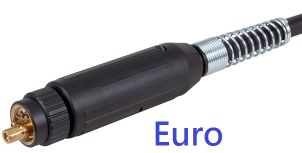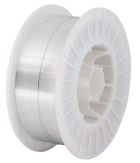How to set up your MIG welder for Aluminium welding

An easy-to-follow, plain english guide on setting up your MIG with Aluminium wire. These instructions apply to most makes and models of MIG welders.
In This Article
Introduction to Welding Aluminium
Do I need a Spool Gun to MIG weld aluminium?
Do I need AC function to MIG weld aluminium?
Welding Machine Requirements
Which WELDCLASS MIG Welders Can I Use With Aluminium?
What type of Aluminium MIG Wire do I need?
Selecting Drive Rollers for Aluminium
MIG Welding Torch Set Up for Aluminium
Welding Aluminium with Spool Gun Torches
Puddling and Cratering
Selecting Gas for Aluminium MIG welding
How to MIG weld Aluminium Video
Some More Tips & Tricks
More Welding Machine Articles Weldclass MIG Welder Range WIN a Weldclass T-Shirt!
An introduction to welding Aluminium
Aluminium is a high thermal conductor (which causes the heat to transfer away from the weld pool faster than other metals), with a melting temperature about half that of steel. This makes it challenging to apply enough heat to maintain the weld pool and achieve penetration, whilst avoiding burn-through and distortion. The thinner the material, the more challenging this becomes. Also, it can be challenging to achieve a 'quality' start to each weld, as this is when the material is at the lowest temperature and therefore draws the most heat away from the weld pool.
In addition, aluminium material has an oxide layer which the arc must penetrate through to be able to initiate a weld. This can make it challenging to start the arc, whilst achieving an aesthetically pleasing weld and avoiding puddling or cratering.
Pulse MIG welders are the ultimate weapon when it comes to welding aluminium. Arc pulsing and functions such as start current (or hot-start), start-slope, end-current, end-slope etc, all allow the operator to control heat and eliminate puddling or cratering & even eliminate spatter. However pulse machines are costly and can require experience to master.
However, with the right equipment and by following best practice, it is possible to successfully MIG weld aluminium, even with relatively basic MIG welding machines. Nowadays, the vast majority of welding machines used (especially single-phase) are inverter machines with "stepless" or "infinite" output adjustment, which allows for much better control of the arc (or heat) - compared to older transformer style machines.
Material thickness: Most reputable MIG machines can be used to weld aluminium down to 3mm thickness. To successfully weld materials thinner than 3mm, it may be neccessary to use specialist MIG or TIG welders with pulse capability. (Note: to TIG weld aluminium, you will need an "AC/DC" machine such as the 201T).
Do you need a Spool Gun to MIG weld aluminium?
No. While it is true that spool guns are often used for aluminium, they are not essential and most reputable machines will allow successful MIG welding of aluminium using a standard torch. Spool guns can improve the ease of set up, however the trade-off is they are heavier and bulkier (can be uncomfortable to use for long periods) and can only be used with mini spools which significantly increases the cost of the wire. See further comments on spool guns below.
Do you need AC function to MIG weld aluminium?
No. While AC (alternating current) is required for TIG welding of aluminium, this is NOT the case for MIG. Virtually all common MIG welding machines operate on DC (direct current) only, whether used for welding steel or aluminium. Even pulse MIG machines, such as the Ultra 220MP, which are considered the 'ultimate' solution for MIG welding aluminium are DC only.
The Welding Machine

If your MIG welder has a torch with "Euro" style connection (like the example above), then setting up for aluminium is usually fairly straight-forward.
The majority of welders in Australia have Euro-connect torches, however some smaller (or low cost) machines have "direct-connect" torches that are "hard wired" into the machine and are not easily disconnected. We do not recommend using these machine for welding aluminium. In some cases it is not possible to make the neccessary changes to the torch, and often these machines will have basic controls that work OK for welding steel, but are not ideal for aluminium.
If your welder has "inductance" and/or "soft-start" adjustments, these are also an advantage when it comes to aluminium. Whilst they are not essential, they do help to fine tune the arc characteristics, control heat, and get a better result. All Weldclass MIG welders (with euro connect torches) have inductance control, with the exception of 180MST.
See more information below regarding inductance and/or soft-start controls.
Which WELDCLASS Welders Can I Use With Aluminium?
Check our quick reference table to confirm which Weldclass welders can be used to MIG weld aluminium.
|
Suitability |
Models |
Comments |
|
Not |
Machine functions and/or torch not suitable for use with aluminium |
|
|
Good |
Reliable machines with simple & easy-to-use controls. |
|
|
Better |
Additional controls such as, manual or synergic/automatic option, soft-start, burn-back, post-gas, etc assist with perfecting aluminium welds. |
|
|
Best |
Single and Double-Pulse functions, making these machines the ultimate weapon for fast, high-quality and low-spatter Aluminium welds. |
Where to buy Weldclass welders
Aluminium MIG Wire
Wire Size
Being a soft metal, the smaller the wire diameter is, the more challenging it will be to achieve reliable wire feeding. You may be accustomed to using 0.9mm as your "go to" size for welding steel, however when it comes to aluminium, 0.9mm is not neccessarily the best option.
For most applications, ø1.0mm is the most common "general purpose" wire size & can be used for welding material down to 3mm thickness (or even 1-2mm if you have a welder capable of this). ø1.2mm is also a popular size, especially for industrial users who need to weld both thinner and heavier material.
ø0.9mm Alu wire should be used "with caution" and only where ø1.0mm wire for some reason is not ideal. A good example of this is the Italian-made Weldclass 210MST machine which has been tuned to perform very well with 0.9mm Alu wire. Otherwise, as a rule-of-thumb we recommend using ø1.0mm.
Avoid using ø0.8mm which can be extremely difficult to wire feed.
If you are using a spool gun torch (more on this topic below), wire size is not so critical becuase the wire has only a very short distance to travel from the spool to the contact tip. 0.9mm & even 0.8mm wires can be much easier to use with spool guns, however that said often 1.0mm wire will often do the some job equally as well.
Wire Type / Grade
The most common grade of wire used for 'general purpose' aluminium fabrication is 5356. Use this selection guide to identify the best wire type for your application.
Aluminium MIG Wire Selection Guide
Drive Rollers for Aluminium
Standard V-groove rollers for steel wire (normally supplied as standard with new machines) will squash softer aluminium wire out of shape. For aluminium, U-groove rollers should be used. These will usually need to be purchased seperately.
Drive Rollers for Weldclass machines
MIG Torch Set Up for Aluminium
_6.jpg)
Torch Liner: If your machine is set up for welding steel, you will need to remove the existing steel liner and replace this with a teflon/poly liner, together with a brass or copper neck liner. You may also need to make some changes to the torch connection on the machine, to accomodate the liner. Click here for instructions on this.
How to Fit & Set Up Teflon/poly Liners
Weldclass Liners for Aluminium
Torch Length: As we've already mentioned, wire feeding with aluminium can be challenging due to aluminium being comparitively very soft. The longer the torch, the more friction there is on the wire, which equals more potential for wire feed problems. The safest torch length for welding aluminium is 3m. If using a 4m torch, we recommend that you use 1.0mm or 1.2mm wire (in preference to 0.9mm), and you will need to to take more care to keep the torch cable straight.
Where a longer "reach" is required, some other options are;
Spool Gun torchs: Available with cables from 4m to 8m long. See further comments below.
Push-Pull torches: Typically avialable with 8-10m cable. These can be costly and not all machines are suitable for operating with push-pull torches.
Additional Torch? If you need to swap between welding aluminium and steel, it can be inconvenient changing over your torch liner etc and then changing it back again. You may want to consider purchasing an additional torch to use as your 'aluminium torch'. For an additional torch, we recommend the Promax BZL 25 torch for machines up to 250A capacity, or the Promax BZL 36 torch for machines 250A and above.
Contact Tip: You will likely need to replace the contact tip in the torch, with the correct size tip to match the wire you are using. Aluminium wire requires slightly "over size" tips. These will usually be available as a specific aluminium tip. For example a 1.0mm aluminium tip will be marked as "1.0A" or "1.0ALU".
Torch Polarity: Most aluminium wires operate on "DC+" polarity, where the torch/wire is connected to the (+) positive terminal, and the earth clamp is connected to the (-) negative terminal.
Welding Aluminium with Spool Gun MIG Torches
First, let's get this clear: Spool guns are not essential for welding aluminium.
Spool guns have pros and cons, with the deciding factors being related to the type of work you do and your work environment - as well as the type of wire or material you are welding.
Pros: Spool guns are available with cable length of up to 8m, allowing welding in areas or parts of a job that may be difficult to access. Swapping between different wires (say steel to aluminium & vice-versa) is also easier with a spool gun than it is with a conventional torch, where you need to replace the complete torch liner and guide tubes in the wire feeder, etc.
Spool guns make good sense for; smaller jobs, low volume work, where flexibility and longer torch length is desired, and when using small diameter wires that can be challenging to use on a conventional torch (such as 0.6mm steel or 0.8/0.9mm aluminium).
Cons: Spool guns are less suited to higher volume / more frequent work. The torch is heavier and bulkier, can be uncomfortable to use for longer periods, and is not ideal for welding in tight spaces or 'out-of-position'.
With a spool gun you are also restricted to use of 100mm "mini-spools", which come at a significantly higher cost per kg of wire than larger spools.
Also, not all MIG welders are suitable for operation with a spool gun (this requires specific programming and a control cable connection) and spool guns are generally not interchangeable between different machine brands/models.
In summary, if your MIG machine has a Euro torch connection and a good quality drive system, our first recommendation is to try a standard 3m or 4m MIG torch. More often than not, this will function well and you won't need to explore further options.
Spool Guns for Weldclass welders
Puddling & Cratering
Avoiding unsightly puddles or craters (especially at the beginning or end of the weld) are some of the most frequent challenges that operators face when welding aluminium.
To completely eliminate these issues 100% may demand the luxury of a Pulse MIG, however experiementing with the following settings can help, even if your machine is non-pulse.
Output/Voltage: A poor start to the weld on aluminium can be due to not enough voltage/heat at that point, or sometimes too much. But more often it is not enough. The reason is that the start of the weld is when the material coldest and therefore draws the most heat away from the weld pool. Experiment with turning up the output (if using synergic mode, dial up to a higher mm thickness setting than what you are actually welding), or if in manual mode, increase the voltage.
The challenge here is that the perfect setting for starting the weld may then be too hot for the remainder of the weld. If you're using a Pulse MIG then you will likely have the luxury of being able to set different current levels for the start, middle & end of the weld. But with standard MIG machines, you will either need to find the best compromise setting, or run short stitch welds to allow a higher start current.
Inductance Control: In some respects, inductance is like adjusting the nozzle on a garden hose.
Low inductance = wide, smooth, fluid arc, which can reduce spatter and improve weld appearance.
High inductance = narrow, focused, crisp arc which can increase spatter levels, but in some applications (especially thinner materials) allows a tighter 'pin point' weld bead.
Note: Some machines may not have inductance control, especially lower cost units.
Soft-Start Adjustment: When a weld is started, the workpiece and the wire will be ‘cold’ compared to welding temperature. This can cause an uneven and poor start to the weld using the voltage and wire feed speed selected as optimal once the arc is established. Soft-Start setting slows the wire speed down at the start of the weld which can improves the weld starting performance.
Note: Some machines may not have soft-start adjustment, especially lower cost units.
Gas for Aluminium MIG welding
Most aluminium wires require 100% Argon shielding gas (as opposed to Argon "mixed" gas - such as Ar+CO2 - which is frequently used for welding steel). Gas mixtures with CO2 cannot be used, as CO2 reacts with aluminum, causing weld contamination and porosity.
Watch the video: How to MIG weld Aluminium
Some great tips from Angus, an experienced aluminium welder and boat builder.
More Tips & Tricks
Wire feed trouble-shooting guide
Spool & wire feed set up for specific Weldclass machines









